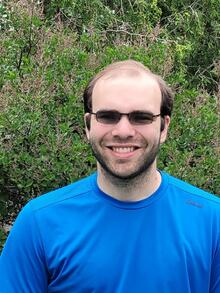The Dean of Science Award honours Master’s students in the Faculty of Science who demonstrate outstanding performance. Speaking with the latest winner, IQC researcher Ryan Ferguson from the Department of Physics and Astronomy, we learned about his award-winning research.
Congratulations on your Dean of Science Award, Ryan. Let’s start off by talking about your Master’s thesis. What did you research?

My master’s research was on hybrid quantum simulations under Christine Muschik, a professor in the physics and astronomy department at IQC. Specifically, I had two projects, one in collaboration with Wolfgang Dür at University of Innsbruck, Karl Jansen at DESY, and Luca Dellantonio and Abdulrahim Al Balushi at IQC and the other in collaboration with Karl Jansen, Stefan Kuhn at University of Vienna, and Chris Wilson and Jinglei Zhang at IQC. For both projects, we were interested in performing hybrid quantum-classical simulations of high-energy quantum theories using a technique called a variational quantum eigensolver (VQE). VQEs are interesting because they allow us to make use of the advantages of quantum computers, even the early ones that we have today, while at the same time making up for their shortcomings using a classical computer. In these projects, we hoped to use VQEs in new and exciting ways to perform simulations that have never been done before.
In the first project, we performed a VQE using the measurement-based system of quantum computing, which is an alternative to the usual circuit model. Instead of manipulating an initial state by applying single- and multi-qubit gates to it and measuring it, in the measurement-based system the initial qubits are entangled with many auxiliary qubits, creating a highly entangled state called a graph state. By performing single-qubit measurements on the graph state, the states of the other qubits change and the unmeasured qubits at the end encode the output state. The measurement-based approach can have advantages over the circuit-based approach depending on the problem being investigated and the hardware it is running on, so we made use of those to design the first measurement-based VQE.
In the second project, we designed a VQE to find the ground state of the U(1)-Higgs model with a topological term in one dimension, which is an important model in high-energy physics. Topological terms are important because, in three dimensions, they give a possible explanation for the observed matter-antimatter imbalance in the universe, so by simulating a model with a topological term in 1D, we lay the groundwork for simulating the 3D model in the future. The VQE procedure we designed used Chris Wilson’s photonic platform as the quantum hardware, the first VQE to do so. As a result, our VQE could make use of the advantages this platform has over VQEs on other platforms.
What is the importance of your research?
In the measurement-based VQE project, we were able to design a VQE that can run on photonic hardware (as well as other types of hardware like superconducting qubits or trapped ions); normally VQEs cannot be done with photons due to the difficulty in performing gates in the circuit model. Also, by designing a custom graph state that was specific to the problem being simulated, our VQE was able to reach states not easily accessible by circuit-based VQEs and in a manner that had a low resource cost. We hope that this work paves the way for future measurement-based VQEs.
For the U(1)-Higgs project, we were successfully able to reach the ground state of the theory in different parameter regimes, observing what was predicted by theoretical studies. In the future, this simulation of a model with a topological term can lead to quantum simulations of the topological term in 3D, where its rich physics can be investigated. Additionally, we hope that this work will lead to future VQEs designed for Chris’ photonic platform, where its highly customizable and unique interactions can be beneficial for simulating some models.
What challenges did you face during your masters?
In both projects I needed to learn a lot before I could even get started. With the measurement-based project, the idea of measurement-based quantum computing was completely new to me, so I needed to work a lot to understand that. In the U(1)-Higgs project, it took some time to understand how Chris Wilson’s photonic platform worked and how we can get the most out of it for our VQE. There were a lot of different approaches we had to consider and a lot of dead-ends. I wouldn’t have been able to get through these projects without the help of others, in particular Christine Muschik, Luca Dellantonio, and Jinglei Zhang. I can’t thank them enough.
What does the Dean of Science Award mean to you?
I am extremely honoured to receive the Dean of Science award! I am happy that the physics community at University of Waterloo finds this research exciting and noteworthy.
What’s next for you?
In the future I’ll be looking for work outside of academia, somewhere in the private sector where I can hopefully put my analytical skills to good use. Fingers crossed!